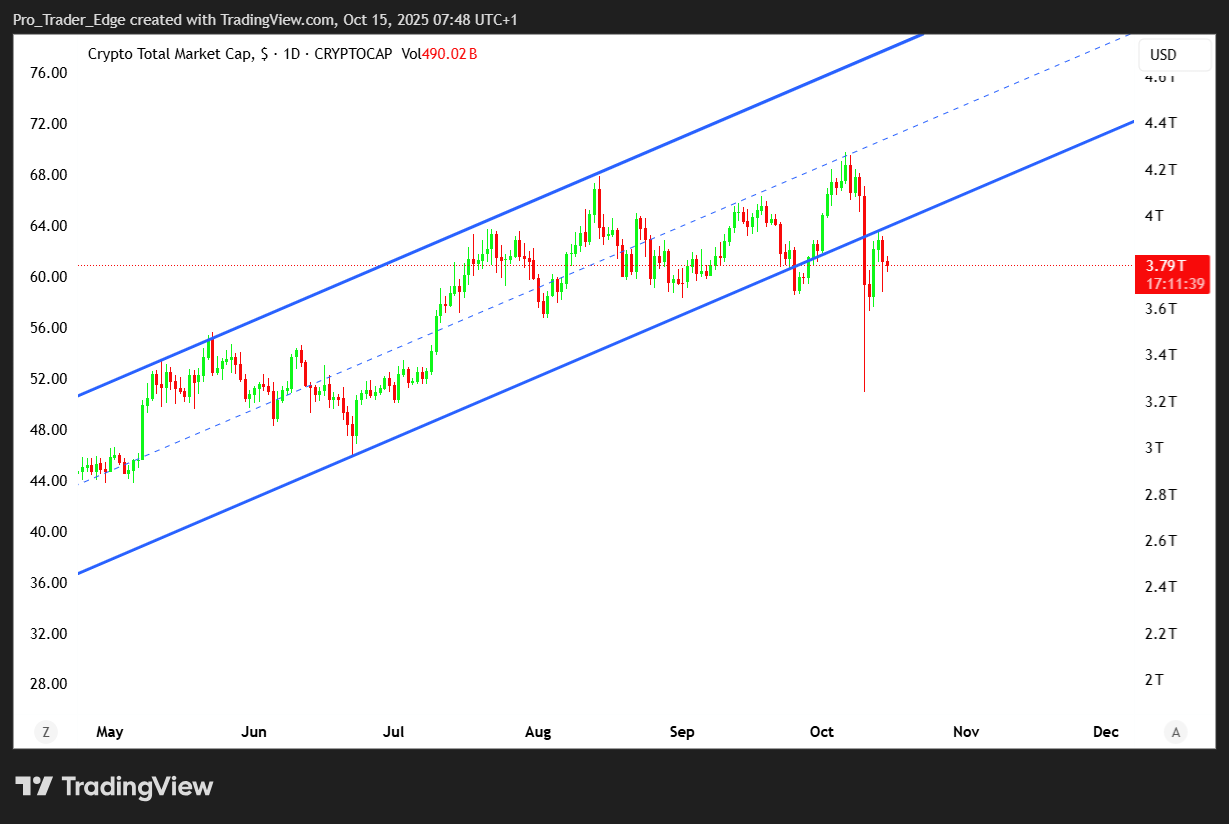TLDR
- Crypto markets recovered to $4 trillion market cap after experiencing the largest liquidation event in history, with over $20 billion in positions wiped out during last weekend’s crash
- Bitcoin dropped below $111,000 but analysts say structural factors like whale accumulation, rising USDT supply, and ETF inflows remain strong
- The crash was driven by structural market forces and deleveraging rather than external events like previous crashes, according to analysts
- October historically sees Bitcoin gains in the second half of the month, with past years showing 16-29% increases after October 15
- CryptoQuant and Glassnode reports show long-term capital remains intact with USDT supply growing $15 billion in 60 days and spot ETF inflows reaching $3.5 billion
The crypto market experienced its largest liquidation event in history last weekend. Over $20 billion in leveraged positions were wiped out in a matter of hours. Despite this massive deleveraging, the market has shown unexpected resilience.
The total crypto market capitalization quickly rebounded to $4 trillion after the weekend crash. Bitcoin retreated below $111,000 on Tuesday after failing to maintain its recovery momentum. Ethereum dropped 3.7% to trade around $4,101.

Crypto podcaster Scott Melker expressed surprise at the market’s recovery. He said he expected October to be deep in the red after the liquidation event. Instead, markets are holding steady.
This crash differs from previous major downturns in the crypto space. There were no external catalysts like the ICO mania of 2017 or the China mining ban. The FTX collapse also didn’t play a role this time.
After the largest liquidation in crypto history, I expected October to be deep in the red. Somehow, it’s still holding on. Which honestly feels like a small miracle.
Let’s get this out of the way: I don’t think we’re entering a bear market.
If I wanted to argue that, I could -…
— The Wolf Of All Streets (@scottmelker) October 14, 2025
Melker characterized the event as purely structural. The liquidations forced traders to reprice risk across the market. This was a technical event rather than a fundamental shift in market conditions.
On-Chain Data Shows Institutional Support
CryptoQuant data reveals that large holders continue to accumulate Bitcoin despite the volatility. USDT supply has grown by nearly $15 billion over the past 60 days. This represents the fastest pace of stablecoin growth since January.
U.S. spot Bitcoin ETF inflows have reached $3.5 billion. This shows institutional interest remains strong even after the liquidation event. Glassnode reports that capital is staying within the crypto ecosystem.
JUST IN: BlackRock CEO Larry Fink announces that their spot #Bitcoin ETF IBIT is "now over $100 billion" in assets 🤯 pic.twitter.com/O1tQW2UV9A
— Bitcoin Magazine (@BitcoinMagazine) October 14, 2025
The on-chain data suggests the sell-off removed speculative excess from the market. Funding rates on perpetual futures contracts dropped by half. Options traders are now paying higher premiums for downside protection.
CryptoQuant identifies $115,000 as a key level for Bitcoin. This represents the on-chain realized price for traders. A sustained move above this level could signal renewed bullish momentum.
Historical Patterns Support Recovery Outlook
October has historically been a strong month for Bitcoin. The cryptocurrency has posted gains in ten of the past twelve Octobers. This pattern earned the month its “Uptober” nickname.
September is ALWAYS the worst month for BTC
But October is ALWAYS the best month for BTC
Last 10 years: Sept avg -7%, Oct avg +48%
Here’s what’s coming next and which alts I’m buying👇🧵 pic.twitter.com/KbetqgCmLt
— Linton Worm (🍏,🪱) (@LintonWorm) September 25, 2025
The strongest gains typically come in the second half of October. In 2024, Bitcoin gained 16% after October 15. The cryptocurrency climbed 29% in the second half of October 2023.
Bitcoin is currently down 0.6% for October. Historical trends suggest the month could still close in positive territory. HashKey Group researcher Tim Sun expects near-term volatility to continue.
Sun said sentiment in the crypto market has not fully recovered. Risk appetite remains subdued following the aggressive deleveraging. Price action is sensitive to headline-driven events.
Gold recently rallied to an all-time high. Melker noted that capital rotation from gold to Bitcoin often follows such moves. Investors appear to be reallocating rather than exiting crypto entirely.
The trade tensions that contributed to the weekend crash are showing signs of easing. President Trump and Chinese President Xi Jinping are scheduled to meet to discuss trade. Sun expects the eventual outcome to be more moderate than current market fears.
Federal Reserve rate cuts remain on the table for later this year. The debasement trade narrative continues to support crypto market sentiment. USDT supply growth indicates fiat liquidity is building in the system.






